Pullman in Key of Sound: The History and Rhythm of a College Town

Nestled among the wheat-covered hills of southeastern Washington, Pullman is often described as a town of students, scientists, and small-town charm. It is home to Washington State University, rich agricultural traditions, and a tight-knit community. But beyond the lecture halls and harvest fields lies a subtler force shaping the town’s identity: music.
From fiddles in rural grange halls to jazz ensembles echoing across campus, Pullman’s sonic landscape has evolved alongside its cultural and intellectual growth. This article explores how sound—both structured and spontaneous—has come to define the rhythms of life in this unique college town.
The Roots: Community Bands and Local Traditions
Long before Pullman was a college town, it was a frontier community. In the late 19th and early 20th centuries, music served as both entertainment and social glue. With limited access to commercial venues or touring performers, residents made their own music—forming brass bands, church choirs, and fiddle circles that animated everything from town meetings to seasonal festivals.
- Grange halls and school auditoriums became impromptu concert venues.
- Winter nights often featured parlor performances and sing-alongs by firelight.
- Music was a way to gather, to cope with isolation, and to mark the passing of seasons.
This spirit of community over commerce laid the groundwork for Pullman’s inclusive and participatory music culture.
The University Effect: WSU and Cultural Expansion
With the rise of Washington State University (WSU), Pullman’s musical life shifted from informal gatherings to structured exploration. The university brought new cultural infrastructure, including the WSU School of Music, which trains students in classical performance, jazz, music education, and composition.
- Concert bands, choirs, orchestras, and jazz combos perform regularly, drawing audiences from across the Palouse.
- Events like the WSU Jazz Festival and faculty recitals showcase both student talent and professional artistry.
- The KZUU student radio station offers an eclectic mix of genres, from indie to global sounds, connecting local listeners with musical movements far beyond campus.
The university expanded both the scope and diversity of Pullman’s musical identity—welcoming everything from electronic experimentation to cultural fusion genres.
Underground Rhythms: House Shows and Independent Scenes
Beyond the formality of university life, Pullman nurtures a vibrant underground music scene, often hidden in plain sight.
- House shows, hosted in off-campus basements or living rooms, feature local punk bands, folk duos, and experimental acts.
- Coffee shops and bars become evening stages for acoustic sets and open mics.
- Student collectives and independent organizers keep the DIY ethos alive.
These grassroots spaces give emerging musicians a place to experiment, connect, and build community. There’s no need for record deals or press coverage—just a room, a crowd, and a few amps.
Pullman’s proximity to Moscow, Idaho, further enhances this ecosystem. Cross-town collaborations, shared festivals, and student exchanges blur borders and foster a regional creative network.
Seasonal Soundtracks and Communal Rituals
In Pullman, music ebbs and flows with both the academic calendar and the rhythm of rural life:
- Fall bursts with energy—marching bands fill stadiums, concerts resume, and first-year students discover local scenes.
- Winter invites more introspective music—recitals, ambient sets, and quiet songwriting sessions.
- Spring brings outdoor concerts, arts festivals, and spontaneous jam sessions under blooming trees.
- Summer slows down but features performances at community events like the National Lentil Festival, which regularly includes regional and local acts.
Music becomes a ritual marker, connecting people not only to each other but to the seasons, the land, and the academic pulse of the town.
The Future: Innovation Meets Intimacy
As Pullman grows and digital platforms reshape how music is made and shared, its music scene faces a challenge: how to embrace innovation without losing intimacy.
New developments include:
- Public music installations in civic spaces
- Collaborations between arts and sciences at WSU
- Virtual performances and remote collaborations, especially post-2020
- Expanded partnerships with local businesses and venues to keep music visible and viable
Yet the essence remains unchanged: Pullman’s music is not mass-produced or fame-driven. It is deeply local, shaped by people who create not to impress the world, but to echo their surroundings.
Conclusion: A Music of Belonging
Pullman may never become a music capital, but that’s part of its charm. Its soundtrack is made of:
- Dorm-room demos
- Improv solos in recital halls
- Foot-stomping folk tunes in grange halls
- Riffs and harmonies under backyard string lights
It is not about the size of the venue or the fame of the artist. It is about the feeling of connection—to place, to people, to sound.
In Pullman, music is not just an art form. It’s a way of belonging.
- WSU School of Music – Performance Calendar & Academic Programs
https://libraries.wsu.edu/masc/university-archives/buildings-history/ - Visit Pullman – Events and Arts
https://www.visit-pullman.com – Highlights seasonal events and performances in Pullman. - City of Moscow Arts Department
https://www.ci.moscow.id.us – Includes collaborative cultural efforts with Pullman. - Books and Articles on College Town Music Scenes
- Kruse, Holly. Site and Sound: Understanding Independent Music Scenes. Peter Lang, 2003.
- Cohen, Sara. “Scenes.” Popular Music, Vol. 20, No. 2 (2001), pp. 223–232.
